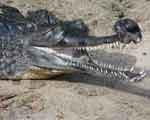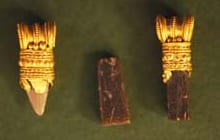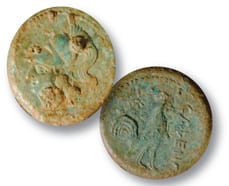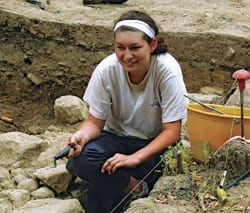Image is first of its kind ever found in an Etruscan excavation
An archaeological excavation at Poggio Colla, the site of a 2,700-year-old Etruscan settlement in Italy’s Mugello Valley, has turned up a surprising and unique find: two images of a woman giving birth to a child.
Researchers from the Mugello Valley Archaeological Project, which oversees the Poggio Colla excavation site some 20 miles northeast of Florence, discovered the images on a small fragment from a ceramic vessel that is more than 2,600 years old.
The images show the head and shoulders of a baby emerging from a mother represented with her knees raised and her face shown in profile, one arm raised, and a long ponytail running down her back.
The excavation is a project of Southern Methodist University, Franklin and Marshall College in Lancaster, Penn., and the University of Pennsylvania Museum of Archaeology and Anthropology, in collaboration with The Open University in Milton Keynes, England.
The identification of the scene was made by Phil Perkins, an authority on Etruscan bucchero and professor of archaeology at The Open University.
“We were astounded to see this intimate scene; it must be the earliest representation of childbirth in Western art,” said Perkins. “Etruscan women are usually represented feasting or participating in rituals, or they are goddesses. Now we have to solve the mystery of who she is and who her child is.”
The Etruscans were the first settlers of Italy, long before the Roman Empire. They built the first cities, were a conduit for the introduction of Greek culture to the Romans, and were known for their art, agriculture, fine metalworking and commerce. They occupied Italy for the first millennium B.C., but were conquered by the Romans and eventually became absorbed into their empire.
Image on elite pottery has implications for Poggio Colla sanctuary worship
“The birth scene is extraordinary, but what is also fascinating is what this image might mean on elite pottery at a sanctuary,” said Greg Warden, professor and associate dean for academic affairs at the Meadows School of the Arts at SMU and a director of the Mugello Valley Archaeological Project.
“Might it have some connection to the cult,” Warden said, “to the kind of worship that went on at the hilltop sanctuary of Poggio Colla?”
The fragment was excavated by William Nutt, who is a graduate student in anthropology at the University of Texas at Arlington and who is legally blind. Nutt was participating in the Poggio Colla Field School, which has operated for six weeks every summer since 1995.
Under the supervision of faculty from U.S. institutions and graduate students in classical archaeology and anthropology, the field school has trained approximately 20 students each year, from more than 70 American and European universities, in the theory and practice of archaeological research. Through excavation and scholarship, these students have played an integral role in understanding the Etruscan occupation of the Mugello Valley.
“I was very grateful to be accepted to the summer program at Poggio Colla — it was my first archaeological dig,” said Nutt, who is attending UTA under a National Science Foundation fellowship.
“I found the artifact at the beginning of my second week there. It was quite dirty, and we weren’t sure what it was until it was cleaned at the onsite lab and identified by Perkins,” Nutt said. “It was thrilling to find out that it was so significant. To make a discovery like that, which provides important new information about a culture we know so little about, is exactly what makes archaeology and anthropology so appealing.”
First image of its type from Etruscan sites
The ceramic fragment is less than 1-3/4 x 1-1/4 inches (4 x 3 cm), from a vessel made of bucchero. Bucchero is a fine, black ceramic material, embellished with stamped and incised decorations, used to make eating and drinking vessels for Etruscan elites.
Typically, stamped designs range from abstract geometric motifs to exotic and mythical animals. There are no known Greek or Roman representations of the moment of birth shown as clearly as the Poggio Colla example until more than 500 years later. The fragment dates to about 600 B.C.E. (Before the Common Era).
Because the site at Poggio Colla has produced numerous votive deposits, scholars are certain that for some part of its history it was a sacred spot to a divinity or divinities.
The abundance of weaving tools and a stunning deposit of gold jewelry discovered earlier have already suggested to some scholars that the patron divinity may have been female; the discovery of the childbirth scene, because of its uniqueness, adds another piece of evidence to the theory.
“This is a most exciting discovery,” said Larissa Bonfante, professor emerita of classics at New York University and a world-renowned expert on the ancient Etruscans. “It shows an image of a type so far unknown in Etruscan context and gives us plenty to think about as we try to understand its religious significance.”
A paper about the find will be presented at the annual meeting of the Archaeological Institute of America in Philadelphia in January. The paper, titled “Defining Northern Etruria: Evidence from Poggio Colla (Vicchio di Mugello),” will be presented by Ann Steiner, provost, dean of the faculty and Shirley Watkins Steinman Professor of Classics at Franklin and Marshall College.
Poggio Colla: Highly significant as it spans Etruscan history
Poggio Colla is a highly significant and rare site. One reason is that it spans most of Etruscan history. Archaeological evidence suggests that the site was occupied from around 700 B.C.E. until 187 B.C.E., when it was destroyed by the Romans. Another reason is that it was not buried under later construction. The Etruscans picked beautiful, easily defended hilltops for their settlements. As a result, generation after generation built new cities on top of their sites. That means many have 2000 years of other civilizations on top of Etruscan settlements and cemeteries. Poggio Colla, however, remained in its original condition. Third, Poggio Colla represents an entire settlement, including tombs, a temple, a pottery factory and an artisan community. Excavations of workshops and living quarters are yielding new details about Etruscan life to scholars.
The site centers on the acropolis, a roughly rectangular plateau of one and a half acres at the summit of Poggio Colla. Excavations have found strong evidence that the acropolis was home to a sanctuary and have identified a temple building and an altar at the center of a large courtyard. Numerous offerings have been found buried around the altar, gifts left behind as part of a sacred ritual to a still unidentified deity. These votive donations range from a massive deposit of nearly 500 varied bronze objects, to a spectacular gift of women’s gold jewelry and semi-precious stones. Another votive deposit contains a collection of ritual objects that were laid to rest in a room at the northwest corner of the sanctuary courtyard, possibly by a priest.
Unique religious context allowed first reconstruction of actual rituals
Excavators discovered a large circular pit, at the center of which was placed a sandstone cylinder, possibly the top of a votive column. Carefully situated near the cylinder were two sandstone statue bases, the larger of which includes the inscribed name of the aristocratic donor. Buried alongside these objects were a strand of gold wire, a purposely broken bronze implement, and two bronze bowls that had been used to pour ritual libations, as well as the bones of a piglet, presumably sacrificed as part of a purification ritual. This unique religious context has allowed researchers to reconstruct, for the first time, the actual rituals and actions of the priest/magistrate who presided over the ceremonies.
Although the Etruscan site now called Poggio Colla has been known since the 19th century, it was first excavated from 1968 to 1972 by Francesco Nicosia, the former Superintendent of Archaeology in Tuscany. With Nicosia’s permission and encouragement, SMU professor Greg Warden, a Mugello Valley native, reopened the site in 1995, established the Mugello Valley Archaeological Project and launched the summer Poggio Colla Field School. Today the project continues to proceed with the permission and supervision of the Soprintendenza per i Beni Archeologici per la Toscana and Luca Fedeli, Inspector.
Directors of the project include Warden; Steiner; Michael L. Thomas, senior research associate at the University of Texas at Austin; and Gretchen Meyers, assistant professor of classics at Franklin & Marshall College. They oversee a team of archaeologists, scientists, architects and conservators who are conducting a systematic and multi-disciplined study of Poggio Colla, including stratigraphic excavation, scientific analysis, geophysical mapping and land surveys. — Victoria Winkelman
SMU is a nationally ranked private university in Dallas founded 100 years ago. Today, SMU enrolls nearly 11,000 students who benefit from the academic opportunities and international reach of seven degree-granting schools. For more information see www.smu.edu.
SMU has an uplink facility located on campus for live TV, radio, or online interviews. To speak with an SMU expert or book an SMU guest in the studio, call SMU News & Communications at 214-768-7650.


 SMU to help solve dangerous refugee water issues
SMU to help solve dangerous refugee water issues











